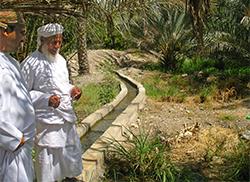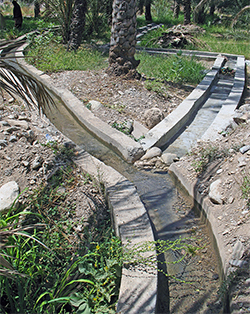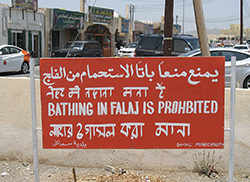It was 47 degrees Celsius. Make that 117 degrees Fahrenheit. In mid-May, the desert of northern Oman may have been the hottest place on the planet. But in the shade of the oasis, the temperature was dramatically cooler. Ali Al Muharbi, in his white robes and beard, beamed as he showed me around the date palms. All were irrigated by water gurgling down a channel dug many centuries ago to tap underground water in the nearby Hajar mountains.

In Oman, a country on the shores of the Arabian Sea, these magical waters conjured from the most arid land imaginable are called “unfailing springs.” Even in the worst droughts, flows persist down the underground tunnels to the surface channels that course through the villages and fields. These pre-Islamic feats of hydraulic engineering remain the only water supply for many villages. Even large towns owe their existence to the perpetually flowing waters. The systems, which remain independent of the state and are run entirely by village communities, are known individually as falaj, and collectively by the plural aflaj.
“The aflaj may be the most ancient community-run systems for managing water in the world,” says Slim Zekri, a water economist at the Sultan Qaboos University in Muscat and a devoted fan. Some tap natural springs; some capture water in gravel beneath the beds of wadis; but the largest and most “unfailing” are those that are connected to the tunnels that bring water down from the mountains. Similar to the ancient qanats of Iran and fogarra in North Africa, they have survived into the modern world better than either.
Until now.
Al Muharbi is the manager of the falaj that waters the village of Al Farfarah, about half an hour’s drive inland from Muscat, the Omani capital. Roughly 1.25 miles of underground tunnel deliver 3.4 gallons of cool mountain water every second to channels that irrigate 100 acres of date palms. Under the shade of the palms grow bananas, fruit trees, winter leafy vegetables, and forage crops for livestock.
But Al Muharbi says that flows in his falaj are declining. And in many villages, the unimaginable is happening: The unfailing springs are drying up.
A decade ago, UNESCO designated five of the best aflaj in Oman as world heritage sites. They have plaques, receive royal visits, and are on the tourist trail. But when I visited one of the famous five, falaj Al-Malki near the town of Izki, I discovered that only two of its 17 channels, which extend for a total of 9 miles, are still in use. And their water is little more than a dribble.
Private greed is wrecking a sustainable and collectively managed water system.
Some blame climate change. But the droughts here are no worse than they have ever been. The real problem, in Izki and elsewhere, is that farmers are sinking private boreholes with pumps in upland areas where the aflaj tap the underground water. The boreholes lower the water tables until they are below the aflaj, leaving the tunnels high and dry. Aflaj, which flow entirely by gravity, are self-limiting: they tap the aquifers but cannot empty them. Pumped boreholes have no such limits — they keep sucking until all the water is gone. They are sabotaging the aflaj.
This is a tragedy of the hydrological commons. Private greed is wrecking a sustainable and collectively managed water system that archaeologists say has been delivering water in this area for 5,000 years. The oases are drying up. The date palms are crashing to the ground. Waterless villages are being abandoned.

I met people who told me privately they fear that the social disruption may trigger the spread of Islamist extremism from neighboring Yemen and Saudi Arabia. There is a history of rebellion in the Hajar mountains. Half a century ago, the British were bombarding rebel villages on behalf of the Sultan, in what turned out to be a dry run for the Americans in Iraq. The pity is that, when their supplies are not disrupted, the aflaj still work remarkably well. Most that I saw were well maintained and had unclogged channels. Engineering features such as siphons, storage tanks, and raised aqueducts were in good working order. Management systems were also in place.
Al Muharbi’s falaj in Al Farfarah is typical. It has some 50 owners — descendants of the people who first put up the money or dug the falaj. For six days a week, the owners each have established rights to water coming down the channel. Timeshares range from half an hour to 15 hours, which is enough to irrigate 500 palm trees. The shares are bought and sold, as some families subdivide land and water for the next generation, while others buy out absent owners. In Al Farfarah, a permanent right to 30 minutes of falaj flow a week costs a bit over $3,000.
The water on the seventh day is open for purchase by those without an established share, or who want more water. Al Muharbi oversees regular auctions in front of the village mosque. Prices vary according to the time of day and the season, but average about $5 for 30 minutes of water — perhaps a tenth of the cost of the desalinated seawater now being brought to many villages for drinking. The auction fees pay for Al Muharbi’s work, running repairs, and charitable activities in the village, such as buying equipment for the school.
Zekri, the economist, thinks these simple water markets are the key to the long-term success of the aflaj. “The existence of private water rights that can be traded makes the system more efficient and allows the community to be self-reliant,” he told me. “They could offer important lessons for the world in how to manage scarce water reserves.”
Certainly, on the evidence of my visit, the complex management systems for sharing the water appears to be widely adhered to. The water entering the village is accessed first for drinking and domestic use, then for the mosque or school, followed by communal bathing cubicles and washing, though soap is banned. Water from these sources returns to the main channel, before heading for the fields along complex networks of channels.
I watched in Al Farfarah as farm workers meticulously kept to their schedule, blocking and unblocking irrigation channels using old rags held down by stones. One water owner berated her workers for not getting water to one palm tree. It could have been a scene from a thousand years ago. But things are changing in the villages.
Nowadays, the water distribution is timed with watches. But Al Muharbi, who is 65, was keen to show me the traditional method used when he was younger. He held a tall stick erect in the village square. As its shadow moved and reached marks in the square, orders would have gone out for which channel should receive water. At night, he remembered using the rising and setting of the stars as a clock. British researcher Harriet Nash found that as recently as a decade ago, eight villages still distributed water according to the stars. None do now.
Officials say a quarter of the aflaj have stopped flowing and a third have seen a sharp decline.
There are other changes. With desalinated seawater now often supplied to villages for domestic use, day-to-day survival no longer depends on falaj waters. Some locals no longer know the rules. Traveling the villages, I saw signs in Arabic and English warning against bathing in delivery channels, and banning the washing of cars with falaj water.
With young Omanis moving to the cities for work, the old men left in charge employ contract workers from South Asia to work their farms. As we walked the channels of his falaj, Al Muharbi was silently followed by his Bangladeshi factotum, Mohammed Islam, who carried a small spade to remove silt. He told me he had been living in the village for five years now.
From the air, the green splashes of date palm plantations clearly mark where aflaj still water the land. A government inventory in the 1990s found just over 4,000 aflaj, of which 3,000 remained in use. They delivered about 916 million cubic yards of water and irrigated some 64,000 acres, up to half of the country’s fields. In an effort to protect them, the government imposed a ban on sinking new wells within two miles of aflaj water-collecting zones. But existing wells are still emptying many aquifers.

Last year, ministers warned that a quarter of the aflaj had stopped flowing since the inventory, and a third had seen a sharp decline. They promised a program of restoration, bringing in engineering companies to clean out and line the water tunnels. But it is not clear how much difference that will make if the aquifers are emptying. And the initiative underlines how indigenous skills have disappeared.
Until the 1970s, a tribe called the Awamir specialized in repairing collapsed tunnels. But they gave up because there was no money in it. Now the government’s contractors send in unskilled foreign laborers to do the repairs. They are brave enough to crawl down dangerous collapsing tunnels. But they lack the traditional skills, says Abdullah Al-Ghafri of the University of Nizwa, who has been researching aflaj for 20 years.
The problem, he says, is that a falaj water tunnel is not simply a conveyor of water. It is also a receiving chamber for water percolating from the rocks above. Unskilled repairers often line the tunnels with concrete in places that receive water during wet times. That seals the tunnel off, killing what they came to cure.
Al-Ghafri wants to set up a research center to increase knowledge of the hydrology of aflaj and preserve the secrets of traditional management. “We need to interview the last Awamir tunnel diggers before they are gone,” he says. He also wants to conduct the first investigation of the conservation value of the aflaj. These systems are the only permanent sources of water in many areas, yet their ecology is largely unknown. There could be an Omani equivalent of the blind white fish that famously inhabits Iranian qanats.
The oases of Oman may be green and cool, but they no longer make economic sense.
But the key to keeping the aflaj may be economic. The low price of dates, their main crop, means nobody makes money from traditional aflaj any more. The oases of Oman may be green and cool, but they no longer make economic sense. Most agree that they need higher value crops. Al-Ghafri plans an experimental farm at the UNESCO-listed falaj Al-Khatmein near his Nizwa campus. He wants to try out using falaj water for aquaculture, hydroponics, and growing vegetables in greenhouses.
Another need is to make more efficient use of falaj water. Zekri says much of it is wasted because it flows constantly to the fields, whether or not it is needed. Farmers routinely over-irrigate. The answer, he says, is to install gates where the tunnels exit the mountain, so flow can be stopped. He is also looking for a village that will try replacing traditional timeshares with smart meters to encourage water conservation.
“The aflaj have to be modernized or they will die,” Zekri says. “But they must remain in community hands. Government control would kill them.” He would like to see the land watered by each village falaj managed as a single farm. The owners would work as a cooperative, pooling their water rights and employing professional staff. But none of this will work, he says, unless the private wells emptying the aquifers are brought under control — perhaps by extending the existing community management of aflaj to include them.
This is a radical agenda. Persuading the government will be hard. Persuading farmers and the elderly custodians of the aflaj like Al Muharbi will be harder still.
Back in his house, Al Muharbi and I sat cross-legged on the floor while Mohammed handed out the year’s first crop of dates and tiny cups of tea. I asked him what he thought the future held for his falaj. His smile for once slipped. “The younger generation aren’t interested,” he said. “It won’t be maintained. It could dry up one day. Perhaps soon.” It is a fatalism that could yet consign the unfailing springs to the history books.